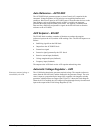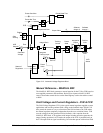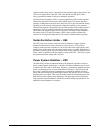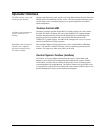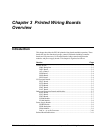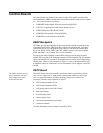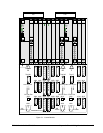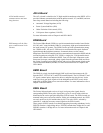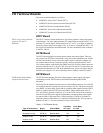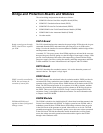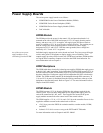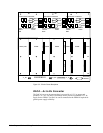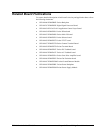
3-4
•
••
•
Chapter 3 Printed Wiring Boards Overview GEH-6632 EX2100 User’s Guide
ACLA Board
ACLA handles network
communications and outer
loop functions.
The ACLA board is a double-slot, 3U high module located next to the DSPX. ACLA
provides Ethernet communications with the turbine control, LCI, and HMI, and runs
outer loop control functions including the following:
• Automatic Voltage Regulator (AVR)
• Power System Stabilizer (PSS)
• Under Excitation Limit control (UEL)
• VAR/power factor regulator (VAR/PF)
For more information refer to Chapter 4 and GEI-100434.
EISB Board
EISB manages all the fiber-
optic communication in the
cabinets.
The Exciter ISBus Board (EISB) is a special communication interface board for the
M1, M2, and C control modules. ISBus is a proprietary, high-speed communication
bus used in many GE systems. The EISB is used to provide communication among
the 3 DSPSs in M1, M2, and C. EISB receives and transmits fiber-optic feedback
signals through the backplane connector. It transmits them over the control
backplane to the DSPX controller and also communicates between the DSPX and the
tool and keypad ports using RS-232C. EISB is a single-slot, 3U high module that is
located in the control rack under the DSPX. From six fiber-optic connectors on the
front panel it accepts current and voltage signals from the generator field (and from
the exciter if required) using EDCF boards, and receives and transmits signals to the
Ground Detection Module (EGDM). For more information refer to Chapter 4 and
GEI-100454.
EMIO Board
The EMIO is a single slot, double height VME style board, that manages the I/O
from the EPCT, ECTB, EACF, and EXTB terminal boards. The I/O include PT and
CT signals, contact inputs, output relay drivers, and pilot trip relay drivers. It also
sends logic level gate pulse signals over the backplane to the ESEL board, which
sends them to EGPA in the power conversion cabinet. For more information refer to
Chapter 4 and GEI-100453.
ESEL Board
The Exciter Selector board receives six logic level gate pulse signals from its
corresponding EMIO. These pulse signals drive up to six sets of cables which are
distributed to the exciter gate pulse amplifier (EGPA) boards. The EGPA boards are
mounted in the power conversion cabinet. If there are redundant controls, two ESEL
are used, one driven by M1 and the other by M2. The active ESEL, selected by
controller C, sends the necessary control signals to the EGPA boards.
Three groups of ESEL boards are available supporting increasing redundancy levels;
ESELH1 contains a single bridge driver, ESELH2 contains three bridge drivers, and
ESELH3 contains six bridge drivers. For more information refer to Chapter 4 and
GEI-100456.



